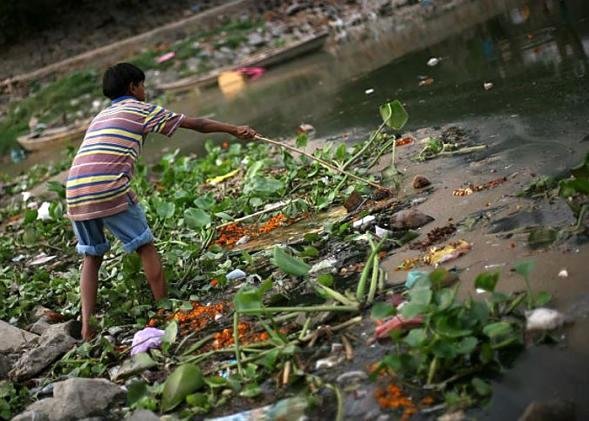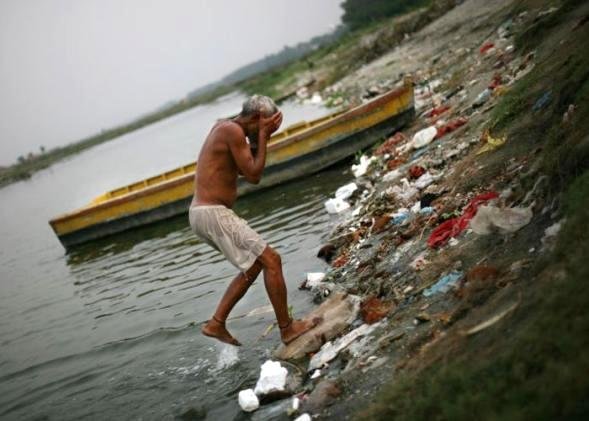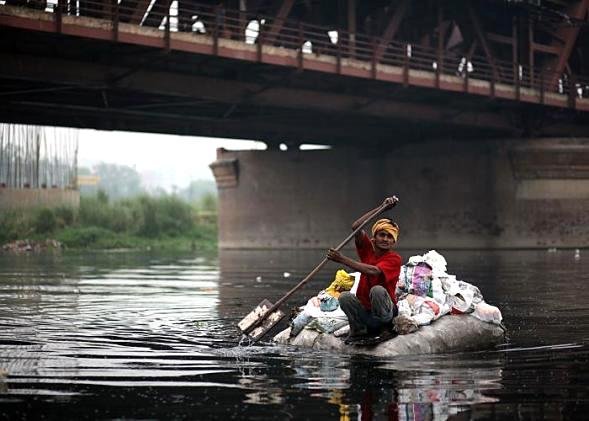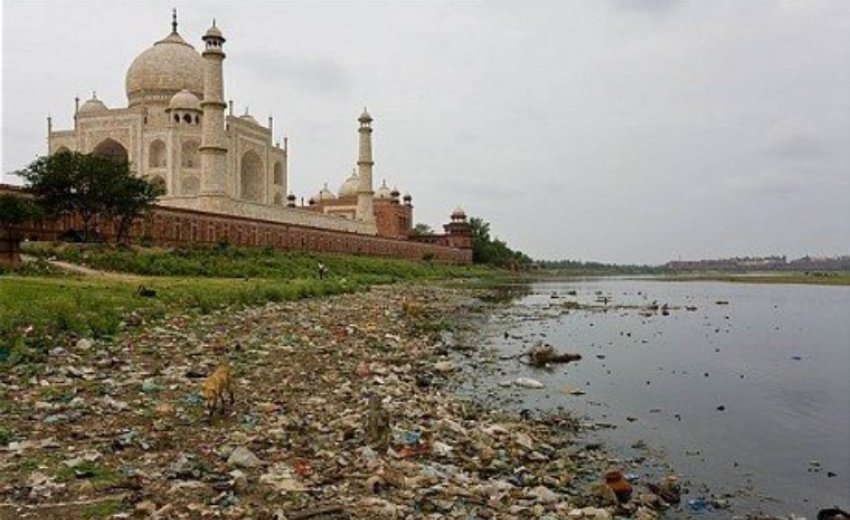 The Yamuna is the largest tributary of the revered Ganges, but its polluted waters pose an increasing health hazard to the Indian capital. Now campaigners are calling for urgent action to clean it up.
The Yamuna is the largest tributary of the revered Ganges, but its polluted waters pose an increasing health hazard to the Indian capital. Now campaigners are calling for urgent action to clean it up.
On Delhi's sacred Yamuna River, beneath a wrought-iron bridge built by the British more than 100 years ago, the remains of the dead were falling on to the living.
From the footbridge – or else from the windows of passing cars and passenger trains – people were throwing bags containing human ashes and garlands of flowers. On the black stinking river below, children sitting astride homemade rafts waited for the bags to fall and then paddled quickly towards them, ripping them apart and collecting the polythene. Sometimes the bags broke open in mid-air, creating a cloud of ash and petals that fell on to those waiting below.

The Yamuna, which passes through Delhi, represents both a terrible irony and one of India's great unsung scandals. The largest tributary of the revered Ganges, the Yamuna is one of the country's most sacred rivers, and yet perhaps also its dirtiest. Hundreds of millions of pounds of public and private money has been spent on projects to clean the river and yet where it passes Delhi it is dark, stinking and lifeless – as dead as a handful of ashes. The water from which dozens of children were eagerly gathering plastic bags is officially rated as being fit only for industrial cooling.

Against this backdrop, campaigners are stepping up their efforts to save the Yamuna and draw public attention to its wretched state. They insist their task is vital. Even now the Yamuna provides the bulk of Delhi's drinking water and campaigners say that unless steps are taken to safeguard this supply, a city that already confronts severe water shortages could be facing a crisis within a decade.
"It's a terrible irony. In the Hindu religion we are supposed to venerate rivers. The Yamuna is one of the most worshipped," said Vimlendu Jha, who heads a campaign group called We For Yamuna. "And yet every day 950 million gallons of sewage is pumped into the river. The faecal coliform [bacteria from human waste] count is 100,000 times what is considered safe for bathing... No politician wants to do anything. It has gone from bad to worse." Most Delhiites barely give a thought for the Yamuna. For the vast majority, the toxic black ribbon that slices through the east of the city – it would be wrong to say the river actually flows – is largely out of sight and out of mind. For those not forced to scrape their survival, there is little reason to visit the Yamuna, except for cremating the dead and scattering their remains according to Hindu tradition.
On a recent morning at Nigambodh Ghat, one of Delhi's largest cremation sites, the family of Kanti Devi were preparing her body for burning. They had ritually bathed her body close to the Yamuna before wrapping it in a white shroud. They had scattered the body with incense and now the men of the family were building a funeral pyre alongside the water, taking turns to stack wood in a pyramid.
Mrs Devi was originally from the state of Uttarakhand. There, said her cousins, the Yamuna was fresh and alive, the water clean enough to drink. The contrast with the water here could not have been more stark. "Where I live the water is clear, but in Delhi there is so much sewage and so much factory waste," said a relative. "Here you cannot drink it, you cannot swim in it."
However bad the river looks from its shoreline, the only way properly to experience the stinking state of affairs in which it finds itself, is to take a boat. Ramesh Chandra is 60 and has been a boatman for 40 years. He remembers when the river was clean enough to see a coin dropped into the water and when fishermen lived on its banks. He used to transport people up and down, from the holy ghats to the bathing ghats and elsewhere. Now the only people who hire him are those wishing to transport a body for cremation or else those scattering ashes.

"No one swims here anymore," he said, as he pushed us off from the shore with a long bamboo pole. "Only those who want to commit suicide."
In the middle of the river the water looked as black as pitch. Methane bubbled up from the depths and plastic bags and other rubbish floated on the surface. Now and then the boat would pass some piece of rotting organic matter being feasted on by a swarm of mosquitoes. A splash of water that entered a cut on my hand stung and itched. Mr Chandra said he had developed eczema from the water.
It was also difficult to breathe without feeling nauseous. The river gave off a stagnant, stale stench that only got worse as the heat of the morning steadily grew. Mr Chandra said he had also developed breathing problems. It was easy to understand why.
The Yamuna ought to be enjoying such better fortunes. Rising in the pristine foothills of Himalayas at Yamunotri, it races south towards the plains surrounding Delhi; 250 miles north of the capital, two canals divert off water for the cities of Punjab and northern Uttar Pradesh. Then, just before it reaches Delhi, the Yamuna is halted by a dam where the city authorities extract 250 million gallons a day. Except during the monsoon, no water is allowed to flow into the stretch that passes the city.

Camels stand in the Yamuna beside The Taj Mahal
"The first step towards saving the Yamuna would be to allow the river to have its own water flow, enough for its minimum ecological survival," said Manoj Misra, who heads another campaign group, Yamuna Jiye Abhiyaan, or Save the Yamuna. He said that because the river received no fresh flow of clean water and yet received a huge daily input of sewage, the toxicity of the water was getting ever more concentrated. One environmental group has measured a doubling of pollution levels between 1993-2005.
Vast sums of money have been set aside for projects to clean the river. In 1993, the Yamuna Action Plan was established with more than £90m from the Japan Bank of International Cooperation. Since then more money from the public has been spent and yet there have been no improvements. There are widespread mutterings of corruption and mismanagement.
Responsibility for the river falls on more than half a dozen federal and local authorities. Yet it is the task of the so-called Delhi Jal Board to provide clean drinking water to the city's 15 million people. A large part of the problem, say officials there, is that large swaths of the city are not connected to the main sewage system, and the system's pipes are so corroded that a full 55 per cent of waste from those connected to the system does not even reach the plants. The result, according to campaigners, is that massive amounts of raw sewage are either directly discharged or else find other circuitous routes into the river, causing up to 80 per cent of its pollution. What's worse, once pumped into the river, the dirty, polluted water can start soaking back into the aquifers and ground water supplies that provides a full 50 per cent of Delhi's supply.
The Jal Board said the challenge of proving clean water was exacerbated by large sprawl of unplanned growth that Delhi has witnessed in recent years. Remarkably the board has claimed that by 2010 – the date when Delhi is to host the Commonwealth Games – it will have halted the discharge of untreated sewage into the river. "The process of cleaning the river involves planned intervention, and we are in the process of completing the works by the target dates," the board's chief executive, Arun Mathur, said earlier this year.
That cannot happen fast enough. Even those politicans tasked with the river's survival admit the awful state of affairs. "If one looks at the river, one almost feels like crying," said Sheila Dikshit, the Chief Minister of Delhi's local government. "In fact, it looks like an acid pond. Today, I don't think that even birds and animals feel like drinking water from the Yamuna."
That may be so, but it does not stop countless number of Delhi's poorest people ekeing out their survival from the filthy river and the rubbish that is thrown into it. Where there were once families of fisherman living alongside the Yamuna, now there are families who make a desperate existence collecting plastic bags recovered from the water.
Mr Chandra, the boatman, pushed us over to the far bank to where Nurali Sheikh and his families lived in a collection of shacks surrounded by piles of plastic. He said contractors paid them four rupees (about five pence) per kilo for the plastic and that on a good day he and his family of six could collect 50 or 60 kilos. "The water here is very dirty, very stinky," said the 70-year-old. "I have never fallen in."

Mr Sheikh came with us to beneath the arches of the bridge where the boat wobbled rather disturbingly and the water too deep for Mr Chandra's bamboo pole. We watched the men, women and children sitting on rafts, their heads looking up, waiting for bags to be thrown down by the commuters.
In addition to the bags of ashes and flowers, some commuters also throw coins into the water, an offering to the Gods to try and ensure them good luck. Bobby, a sinewy 31-year-old in shorts, was one of many who scratch a living from such acts of piety. Armed with a large magnet in the shape of a dumbell and a strong rope, he trawled the depths for coins. He had been doing so for 12 years and said that on a good day he could make up to 200 rupees, or £2.50. "People give money to God, they throw the coins in," he said. Bobby said he paid little attention to the state of the Yamuna though he admitted, perhaps with an element of marvel, that he had heard the river was once clean. "I'm not worried about it," he said, asked about the potential for falling ill from the polluted water. "I'm used to it."
By now the sun was climbing into the mid-morning sky and we started the journey back upstream through the still, fetid water. On the way a number of white birds – they may have been egrets or herons – flew out from the reeds. One could not help but wonder what they survived on, given that the river looked so dead. Next to one of gatherings of shacks a young girl joyously submerged herself in the water before doing the same with her dog. On the other bank at a ghat where people once came from across the city to bathe in the holy river, a group of young boys was taking turns to run and leap from the steps into the water.
Back at the cremation grounds from where we had set off, the pyre that had been built by the relatives of Kanti Devi was well ablaze. The men sat talking together under an awning close to the Yamuna, watching the flames dance and waiting patiently for her body to be fully cremated.
Then, once the fire had cooled, they would gather up the ashes and throw them into the water.
By Andrew Buncombe
Thursday, 1 May 2008
Andrew Buncombe reports from India at independent.co.uk/asiablog
Photos by Daniel Pepper

